Business Law Case: Negligence, Financial Advice, & Duty of Care
VerifiedAdded on 2023/03/30
|9
|2070
|351
Case Study
AI Summary
This case study analyzes two distinct legal issues: first, whether Raylene can claim against Slonia for negligent misstatement regarding financial advice that led to business losses, and second, whether Paul can claim against Weldon, AK Manufacturing, or Mechanangello for negligence related to a faulty quadbike. The analysis of Raylene's situation applies principles from cases like Hedley Byrne & Co v Heller to determine if Slonia, as a financial advisor, owed Raylene a duty of care and breached it through negligent advice. The quadbike incident involves assessing negligence in manufacturing, referencing Donoghue v Stevenson and Heaven v Pender, to establish potential liability for AK Manufacturing, Weldon, and Mechanangello due to the faulty welding and design of the quadbike. The study concludes that Raylene has grounds to claim against Slonia, and Paul has grounds to claim against AK Manufacturing, Weldon, and Mechanangello, based on principles of negligence and vicarious liability.
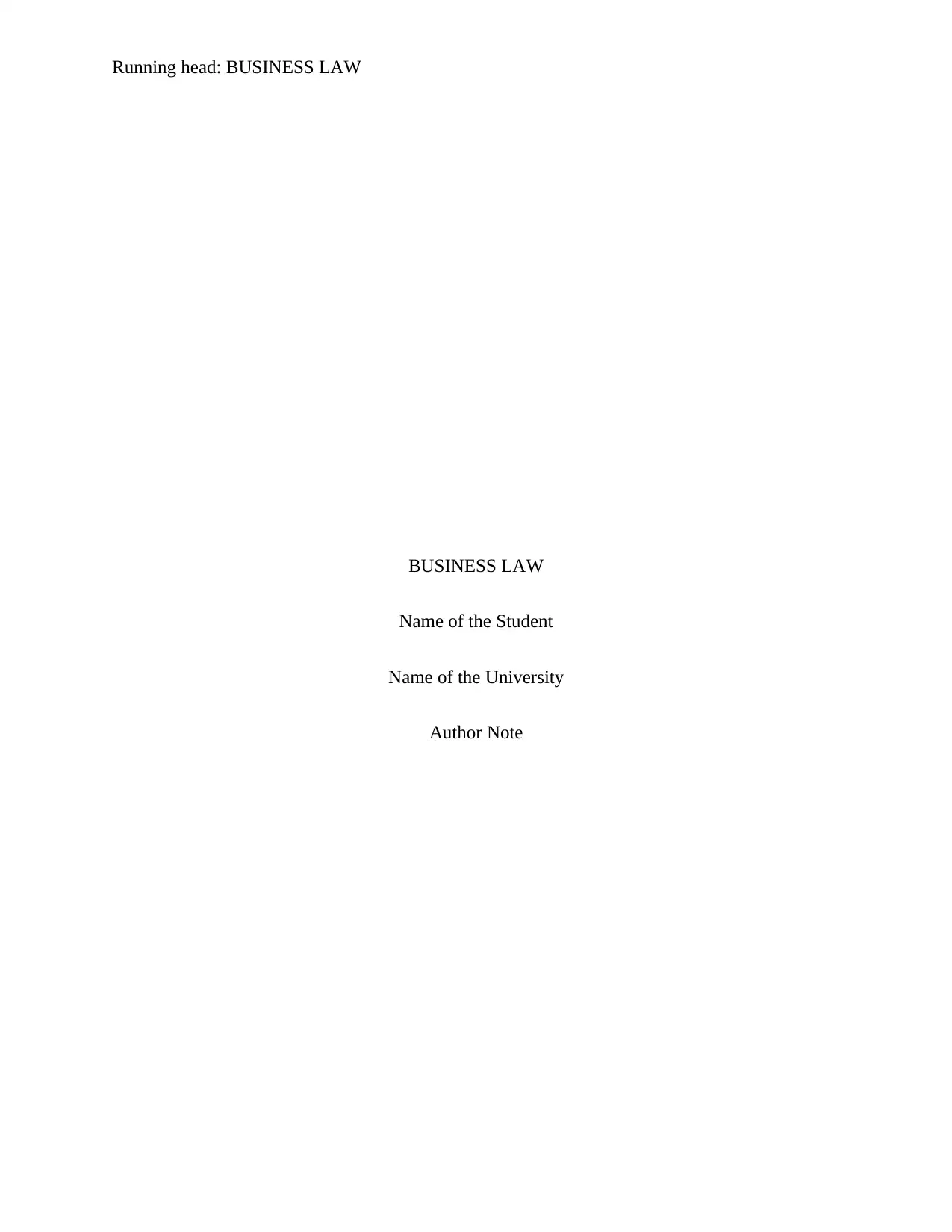
Running head: BUSINESS LAW
BUSINESS LAW
Name of the Student
Name of the University
Author Note
BUSINESS LAW
Name of the Student
Name of the University
Author Note
Paraphrase This Document
Need a fresh take? Get an instant paraphrase of this document with our AI Paraphraser
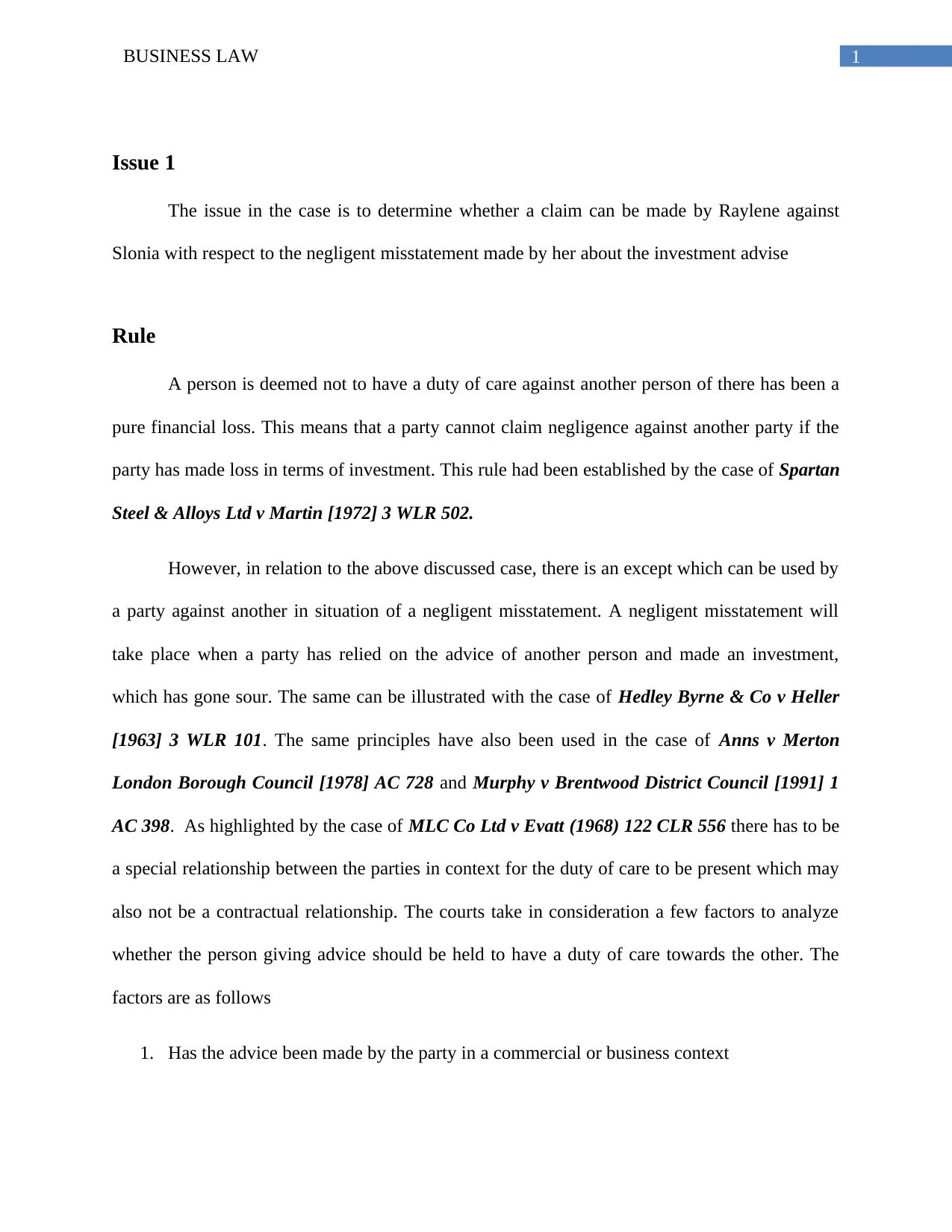
1BUSINESS LAW
Issue 1
The issue in the case is to determine whether a claim can be made by Raylene against
Slonia with respect to the negligent misstatement made by her about the investment advise
Rule
A person is deemed not to have a duty of care against another person of there has been a
pure financial loss. This means that a party cannot claim negligence against another party if the
party has made loss in terms of investment. This rule had been established by the case of Spartan
Steel & Alloys Ltd v Martin [1972] 3 WLR 502.
However, in relation to the above discussed case, there is an except which can be used by
a party against another in situation of a negligent misstatement. A negligent misstatement will
take place when a party has relied on the advice of another person and made an investment,
which has gone sour. The same can be illustrated with the case of Hedley Byrne & Co v Heller
[1963] 3 WLR 101. The same principles have also been used in the case of Anns v Merton
London Borough Council [1978] AC 728 and Murphy v Brentwood District Council [1991] 1
AC 398. As highlighted by the case of MLC Co Ltd v Evatt (1968) 122 CLR 556 there has to be
a special relationship between the parties in context for the duty of care to be present which may
also not be a contractual relationship. The courts take in consideration a few factors to analyze
whether the person giving advice should be held to have a duty of care towards the other. The
factors are as follows
1. Has the advice been made by the party in a commercial or business context
Issue 1
The issue in the case is to determine whether a claim can be made by Raylene against
Slonia with respect to the negligent misstatement made by her about the investment advise
Rule
A person is deemed not to have a duty of care against another person of there has been a
pure financial loss. This means that a party cannot claim negligence against another party if the
party has made loss in terms of investment. This rule had been established by the case of Spartan
Steel & Alloys Ltd v Martin [1972] 3 WLR 502.
However, in relation to the above discussed case, there is an except which can be used by
a party against another in situation of a negligent misstatement. A negligent misstatement will
take place when a party has relied on the advice of another person and made an investment,
which has gone sour. The same can be illustrated with the case of Hedley Byrne & Co v Heller
[1963] 3 WLR 101. The same principles have also been used in the case of Anns v Merton
London Borough Council [1978] AC 728 and Murphy v Brentwood District Council [1991] 1
AC 398. As highlighted by the case of MLC Co Ltd v Evatt (1968) 122 CLR 556 there has to be
a special relationship between the parties in context for the duty of care to be present which may
also not be a contractual relationship. The courts take in consideration a few factors to analyze
whether the person giving advice should be held to have a duty of care towards the other. The
factors are as follows
1. Has the advice been made by the party in a commercial or business context
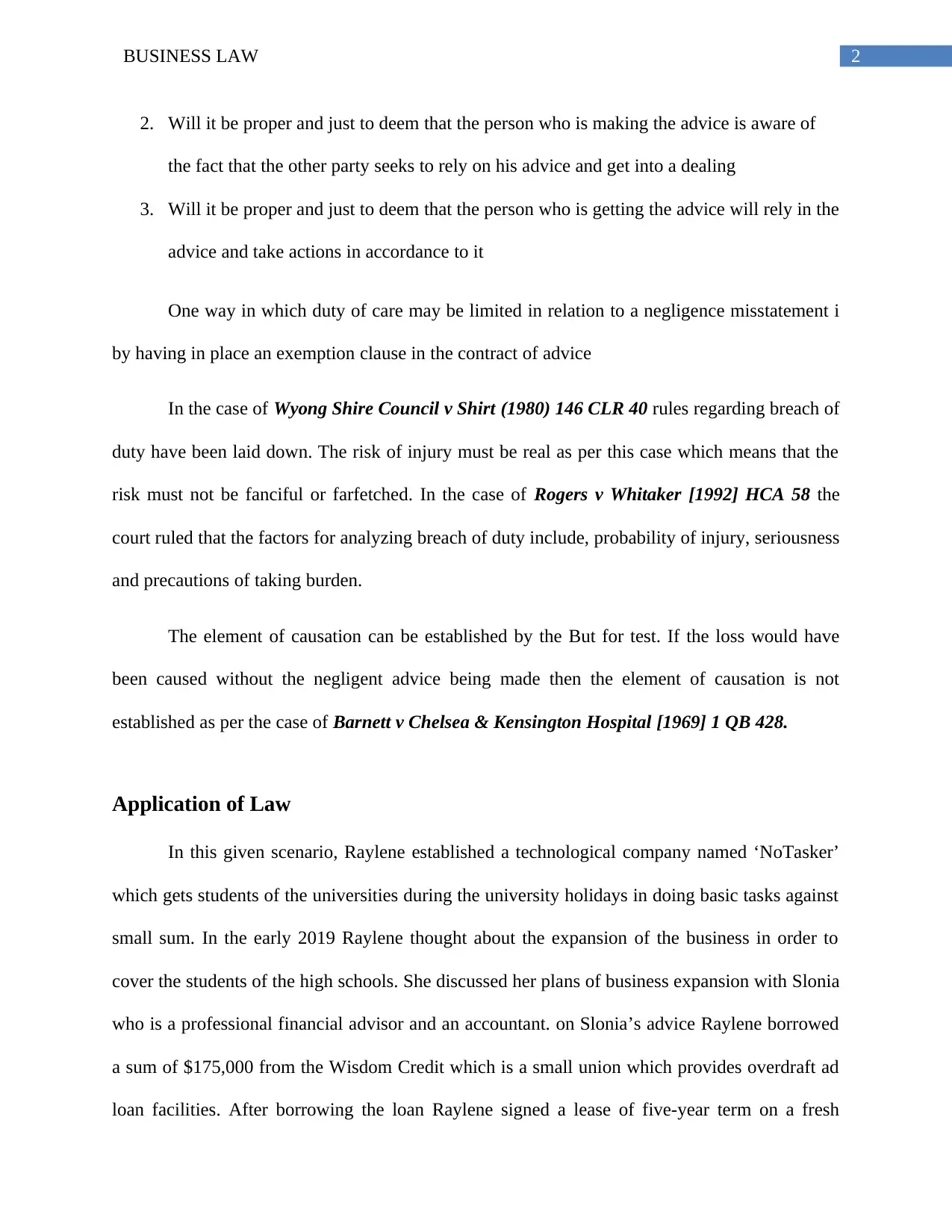
2BUSINESS LAW
2. Will it be proper and just to deem that the person who is making the advice is aware of
the fact that the other party seeks to rely on his advice and get into a dealing
3. Will it be proper and just to deem that the person who is getting the advice will rely in the
advice and take actions in accordance to it
One way in which duty of care may be limited in relation to a negligence misstatement i
by having in place an exemption clause in the contract of advice
In the case of Wyong Shire Council v Shirt (1980) 146 CLR 40 rules regarding breach of
duty have been laid down. The risk of injury must be real as per this case which means that the
risk must not be fanciful or farfetched. In the case of Rogers v Whitaker [1992] HCA 58 the
court ruled that the factors for analyzing breach of duty include, probability of injury, seriousness
and precautions of taking burden.
The element of causation can be established by the But for test. If the loss would have
been caused without the negligent advice being made then the element of causation is not
established as per the case of Barnett v Chelsea & Kensington Hospital [1969] 1 QB 428.
Application of Law
In this given scenario, Raylene established a technological company named ‘NoTasker’
which gets students of the universities during the university holidays in doing basic tasks against
small sum. In the early 2019 Raylene thought about the expansion of the business in order to
cover the students of the high schools. She discussed her plans of business expansion with Slonia
who is a professional financial advisor and an accountant. on Slonia’s advice Raylene borrowed
a sum of $175,000 from the Wisdom Credit which is a small union which provides overdraft ad
loan facilities. After borrowing the loan Raylene signed a lease of five-year term on a fresh
2. Will it be proper and just to deem that the person who is making the advice is aware of
the fact that the other party seeks to rely on his advice and get into a dealing
3. Will it be proper and just to deem that the person who is getting the advice will rely in the
advice and take actions in accordance to it
One way in which duty of care may be limited in relation to a negligence misstatement i
by having in place an exemption clause in the contract of advice
In the case of Wyong Shire Council v Shirt (1980) 146 CLR 40 rules regarding breach of
duty have been laid down. The risk of injury must be real as per this case which means that the
risk must not be fanciful or farfetched. In the case of Rogers v Whitaker [1992] HCA 58 the
court ruled that the factors for analyzing breach of duty include, probability of injury, seriousness
and precautions of taking burden.
The element of causation can be established by the But for test. If the loss would have
been caused without the negligent advice being made then the element of causation is not
established as per the case of Barnett v Chelsea & Kensington Hospital [1969] 1 QB 428.
Application of Law
In this given scenario, Raylene established a technological company named ‘NoTasker’
which gets students of the universities during the university holidays in doing basic tasks against
small sum. In the early 2019 Raylene thought about the expansion of the business in order to
cover the students of the high schools. She discussed her plans of business expansion with Slonia
who is a professional financial advisor and an accountant. on Slonia’s advice Raylene borrowed
a sum of $175,000 from the Wisdom Credit which is a small union which provides overdraft ad
loan facilities. After borrowing the loan Raylene signed a lease of five-year term on a fresh
⊘ This is a preview!⊘
Do you want full access?
Subscribe today to unlock all pages.

Trusted by 1+ million students worldwide
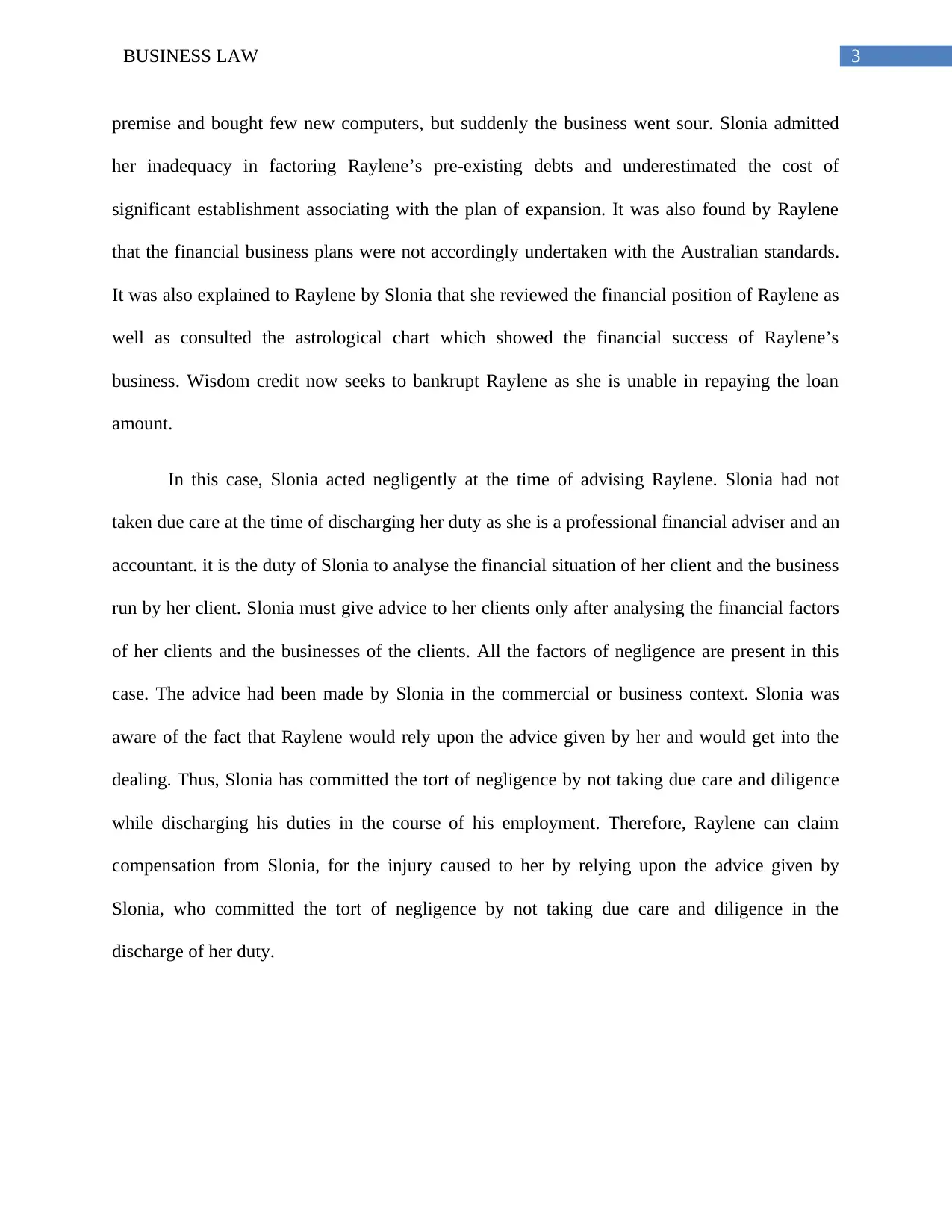
3BUSINESS LAW
premise and bought few new computers, but suddenly the business went sour. Slonia admitted
her inadequacy in factoring Raylene’s pre-existing debts and underestimated the cost of
significant establishment associating with the plan of expansion. It was also found by Raylene
that the financial business plans were not accordingly undertaken with the Australian standards.
It was also explained to Raylene by Slonia that she reviewed the financial position of Raylene as
well as consulted the astrological chart which showed the financial success of Raylene’s
business. Wisdom credit now seeks to bankrupt Raylene as she is unable in repaying the loan
amount.
In this case, Slonia acted negligently at the time of advising Raylene. Slonia had not
taken due care at the time of discharging her duty as she is a professional financial adviser and an
accountant. it is the duty of Slonia to analyse the financial situation of her client and the business
run by her client. Slonia must give advice to her clients only after analysing the financial factors
of her clients and the businesses of the clients. All the factors of negligence are present in this
case. The advice had been made by Slonia in the commercial or business context. Slonia was
aware of the fact that Raylene would rely upon the advice given by her and would get into the
dealing. Thus, Slonia has committed the tort of negligence by not taking due care and diligence
while discharging his duties in the course of his employment. Therefore, Raylene can claim
compensation from Slonia, for the injury caused to her by relying upon the advice given by
Slonia, who committed the tort of negligence by not taking due care and diligence in the
discharge of her duty.
premise and bought few new computers, but suddenly the business went sour. Slonia admitted
her inadequacy in factoring Raylene’s pre-existing debts and underestimated the cost of
significant establishment associating with the plan of expansion. It was also found by Raylene
that the financial business plans were not accordingly undertaken with the Australian standards.
It was also explained to Raylene by Slonia that she reviewed the financial position of Raylene as
well as consulted the astrological chart which showed the financial success of Raylene’s
business. Wisdom credit now seeks to bankrupt Raylene as she is unable in repaying the loan
amount.
In this case, Slonia acted negligently at the time of advising Raylene. Slonia had not
taken due care at the time of discharging her duty as she is a professional financial adviser and an
accountant. it is the duty of Slonia to analyse the financial situation of her client and the business
run by her client. Slonia must give advice to her clients only after analysing the financial factors
of her clients and the businesses of the clients. All the factors of negligence are present in this
case. The advice had been made by Slonia in the commercial or business context. Slonia was
aware of the fact that Raylene would rely upon the advice given by her and would get into the
dealing. Thus, Slonia has committed the tort of negligence by not taking due care and diligence
while discharging his duties in the course of his employment. Therefore, Raylene can claim
compensation from Slonia, for the injury caused to her by relying upon the advice given by
Slonia, who committed the tort of negligence by not taking due care and diligence in the
discharge of her duty.
Paraphrase This Document
Need a fresh take? Get an instant paraphrase of this document with our AI Paraphraser
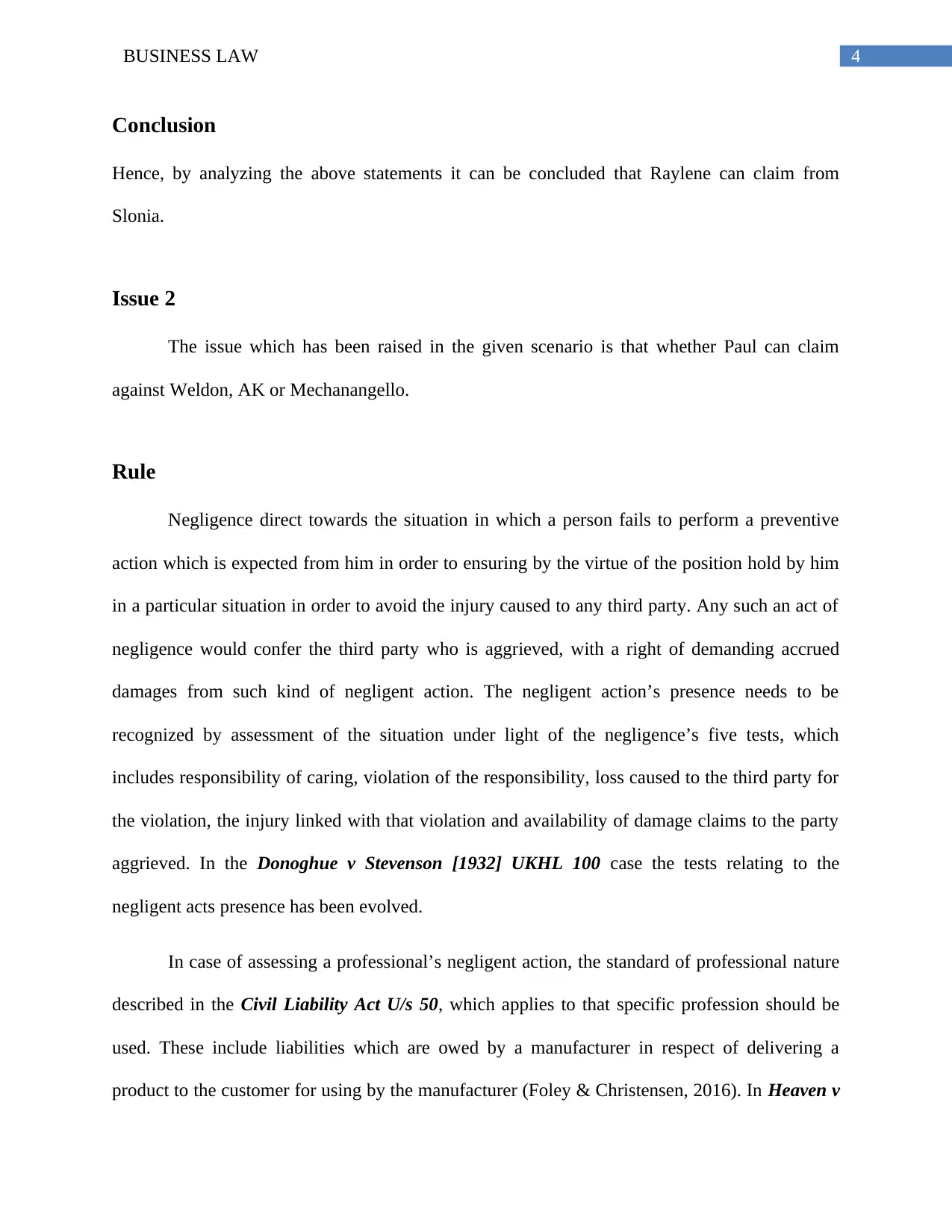
4BUSINESS LAW
Conclusion
Hence, by analyzing the above statements it can be concluded that Raylene can claim from
Slonia.
Issue 2
The issue which has been raised in the given scenario is that whether Paul can claim
against Weldon, AK or Mechanangello.
Rule
Negligence direct towards the situation in which a person fails to perform a preventive
action which is expected from him in order to ensuring by the virtue of the position hold by him
in a particular situation in order to avoid the injury caused to any third party. Any such an act of
negligence would confer the third party who is aggrieved, with a right of demanding accrued
damages from such kind of negligent action. The negligent action’s presence needs to be
recognized by assessment of the situation under light of the negligence’s five tests, which
includes responsibility of caring, violation of the responsibility, loss caused to the third party for
the violation, the injury linked with that violation and availability of damage claims to the party
aggrieved. In the Donoghue v Stevenson [1932] UKHL 100 case the tests relating to the
negligent acts presence has been evolved.
In case of assessing a professional’s negligent action, the standard of professional nature
described in the Civil Liability Act U/s 50, which applies to that specific profession should be
used. These include liabilities which are owed by a manufacturer in respect of delivering a
product to the customer for using by the manufacturer (Foley & Christensen, 2016). In Heaven v
Conclusion
Hence, by analyzing the above statements it can be concluded that Raylene can claim from
Slonia.
Issue 2
The issue which has been raised in the given scenario is that whether Paul can claim
against Weldon, AK or Mechanangello.
Rule
Negligence direct towards the situation in which a person fails to perform a preventive
action which is expected from him in order to ensuring by the virtue of the position hold by him
in a particular situation in order to avoid the injury caused to any third party. Any such an act of
negligence would confer the third party who is aggrieved, with a right of demanding accrued
damages from such kind of negligent action. The negligent action’s presence needs to be
recognized by assessment of the situation under light of the negligence’s five tests, which
includes responsibility of caring, violation of the responsibility, loss caused to the third party for
the violation, the injury linked with that violation and availability of damage claims to the party
aggrieved. In the Donoghue v Stevenson [1932] UKHL 100 case the tests relating to the
negligent acts presence has been evolved.
In case of assessing a professional’s negligent action, the standard of professional nature
described in the Civil Liability Act U/s 50, which applies to that specific profession should be
used. These include liabilities which are owed by a manufacturer in respect of delivering a
product to the customer for using by the manufacturer (Foley & Christensen, 2016). In Heaven v
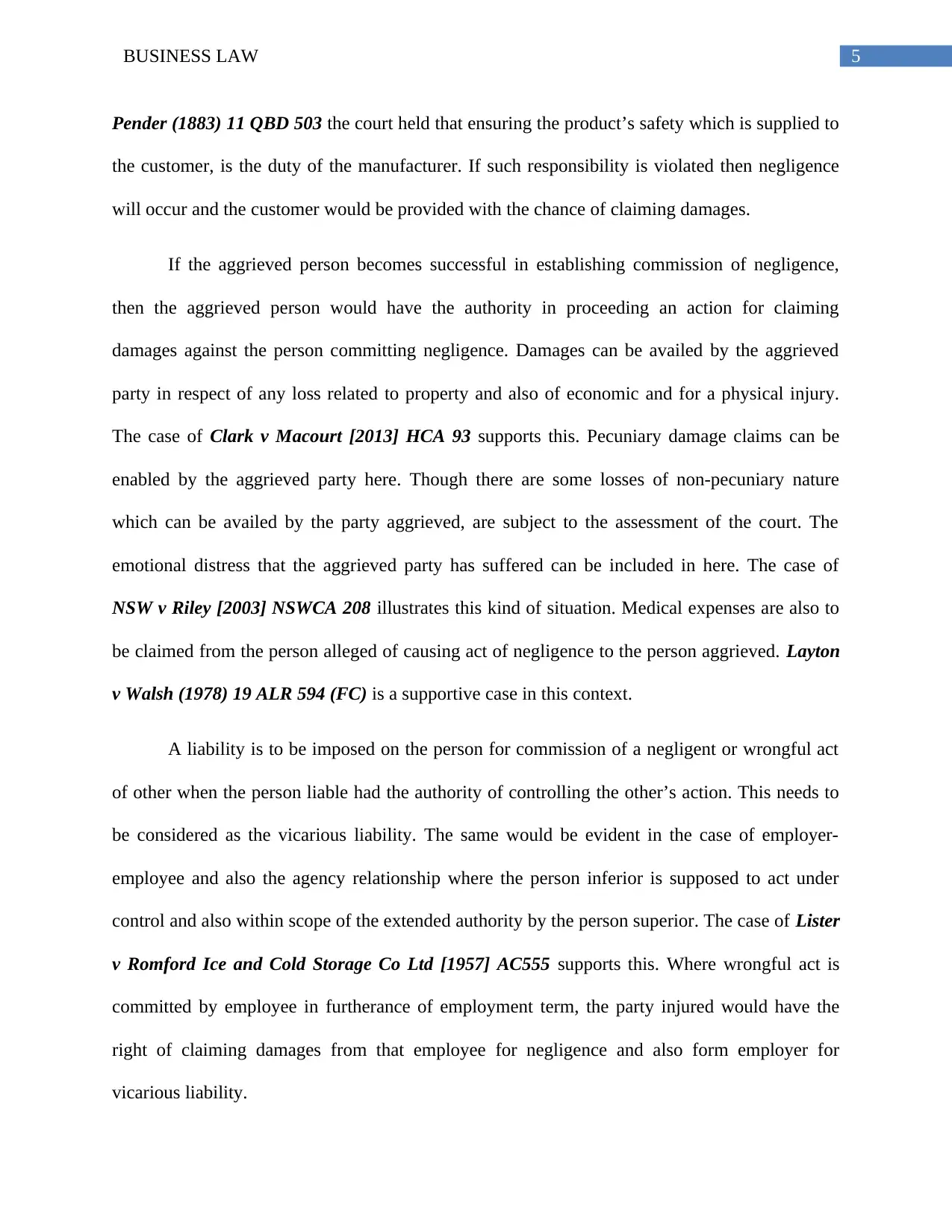
5BUSINESS LAW
Pender (1883) 11 QBD 503 the court held that ensuring the product’s safety which is supplied to
the customer, is the duty of the manufacturer. If such responsibility is violated then negligence
will occur and the customer would be provided with the chance of claiming damages.
If the aggrieved person becomes successful in establishing commission of negligence,
then the aggrieved person would have the authority in proceeding an action for claiming
damages against the person committing negligence. Damages can be availed by the aggrieved
party in respect of any loss related to property and also of economic and for a physical injury.
The case of Clark v Macourt [2013] HCA 93 supports this. Pecuniary damage claims can be
enabled by the aggrieved party here. Though there are some losses of non-pecuniary nature
which can be availed by the party aggrieved, are subject to the assessment of the court. The
emotional distress that the aggrieved party has suffered can be included in here. The case of
NSW v Riley [2003] NSWCA 208 illustrates this kind of situation. Medical expenses are also to
be claimed from the person alleged of causing act of negligence to the person aggrieved. Layton
v Walsh (1978) 19 ALR 594 (FC) is a supportive case in this context.
A liability is to be imposed on the person for commission of a negligent or wrongful act
of other when the person liable had the authority of controlling the other’s action. This needs to
be considered as the vicarious liability. The same would be evident in the case of employer-
employee and also the agency relationship where the person inferior is supposed to act under
control and also within scope of the extended authority by the person superior. The case of Lister
v Romford Ice and Cold Storage Co Ltd [1957] AC555 supports this. Where wrongful act is
committed by employee in furtherance of employment term, the party injured would have the
right of claiming damages from that employee for negligence and also form employer for
vicarious liability.
Pender (1883) 11 QBD 503 the court held that ensuring the product’s safety which is supplied to
the customer, is the duty of the manufacturer. If such responsibility is violated then negligence
will occur and the customer would be provided with the chance of claiming damages.
If the aggrieved person becomes successful in establishing commission of negligence,
then the aggrieved person would have the authority in proceeding an action for claiming
damages against the person committing negligence. Damages can be availed by the aggrieved
party in respect of any loss related to property and also of economic and for a physical injury.
The case of Clark v Macourt [2013] HCA 93 supports this. Pecuniary damage claims can be
enabled by the aggrieved party here. Though there are some losses of non-pecuniary nature
which can be availed by the party aggrieved, are subject to the assessment of the court. The
emotional distress that the aggrieved party has suffered can be included in here. The case of
NSW v Riley [2003] NSWCA 208 illustrates this kind of situation. Medical expenses are also to
be claimed from the person alleged of causing act of negligence to the person aggrieved. Layton
v Walsh (1978) 19 ALR 594 (FC) is a supportive case in this context.
A liability is to be imposed on the person for commission of a negligent or wrongful act
of other when the person liable had the authority of controlling the other’s action. This needs to
be considered as the vicarious liability. The same would be evident in the case of employer-
employee and also the agency relationship where the person inferior is supposed to act under
control and also within scope of the extended authority by the person superior. The case of Lister
v Romford Ice and Cold Storage Co Ltd [1957] AC555 supports this. Where wrongful act is
committed by employee in furtherance of employment term, the party injured would have the
right of claiming damages from that employee for negligence and also form employer for
vicarious liability.
⊘ This is a preview!⊘
Do you want full access?
Subscribe today to unlock all pages.

Trusted by 1+ million students worldwide
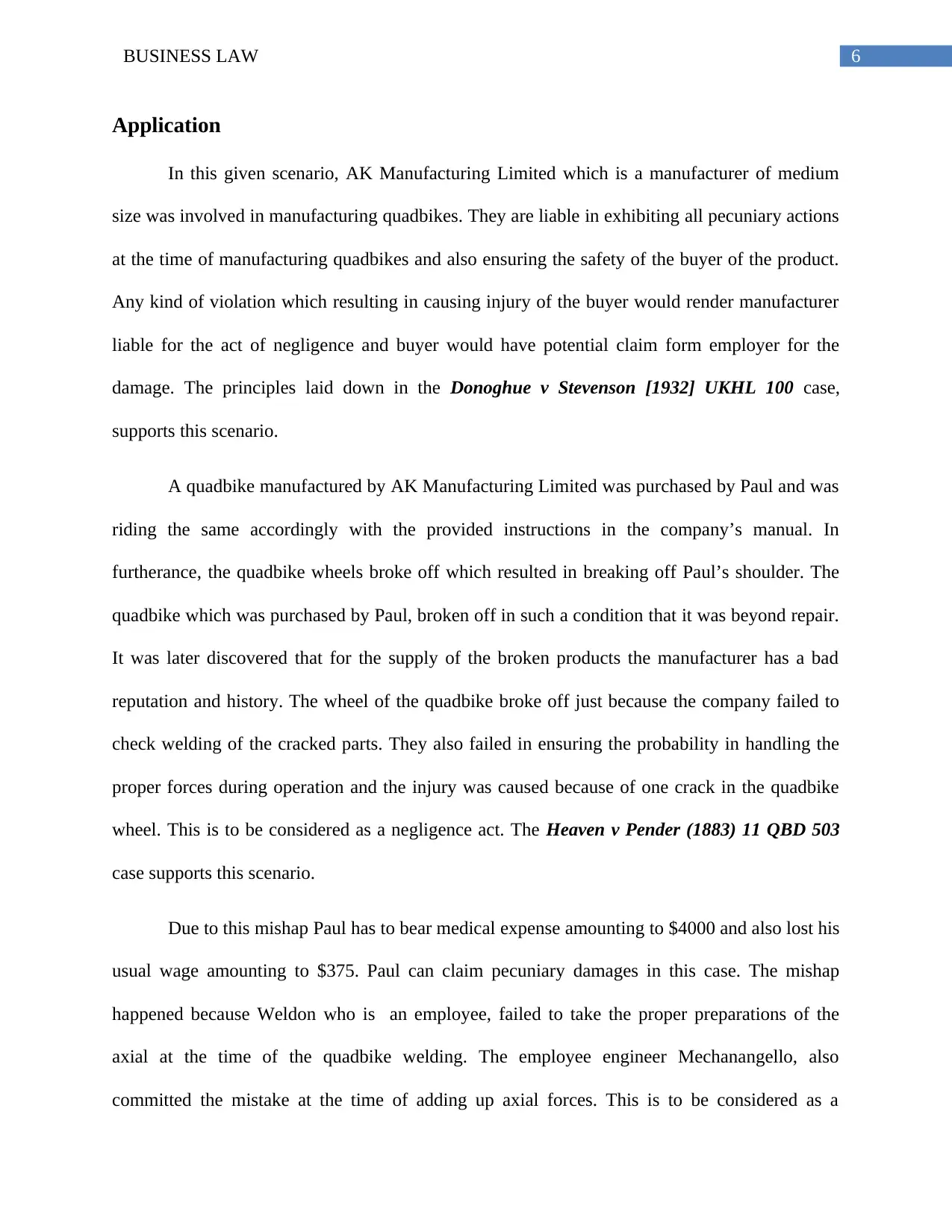
6BUSINESS LAW
Application
In this given scenario, AK Manufacturing Limited which is a manufacturer of medium
size was involved in manufacturing quadbikes. They are liable in exhibiting all pecuniary actions
at the time of manufacturing quadbikes and also ensuring the safety of the buyer of the product.
Any kind of violation which resulting in causing injury of the buyer would render manufacturer
liable for the act of negligence and buyer would have potential claim form employer for the
damage. The principles laid down in the Donoghue v Stevenson [1932] UKHL 100 case,
supports this scenario.
A quadbike manufactured by AK Manufacturing Limited was purchased by Paul and was
riding the same accordingly with the provided instructions in the company’s manual. In
furtherance, the quadbike wheels broke off which resulted in breaking off Paul’s shoulder. The
quadbike which was purchased by Paul, broken off in such a condition that it was beyond repair.
It was later discovered that for the supply of the broken products the manufacturer has a bad
reputation and history. The wheel of the quadbike broke off just because the company failed to
check welding of the cracked parts. They also failed in ensuring the probability in handling the
proper forces during operation and the injury was caused because of one crack in the quadbike
wheel. This is to be considered as a negligence act. The Heaven v Pender (1883) 11 QBD 503
case supports this scenario.
Due to this mishap Paul has to bear medical expense amounting to $4000 and also lost his
usual wage amounting to $375. Paul can claim pecuniary damages in this case. The mishap
happened because Weldon who is an employee, failed to take the proper preparations of the
axial at the time of the quadbike welding. The employee engineer Mechanangello, also
committed the mistake at the time of adding up axial forces. This is to be considered as a
Application
In this given scenario, AK Manufacturing Limited which is a manufacturer of medium
size was involved in manufacturing quadbikes. They are liable in exhibiting all pecuniary actions
at the time of manufacturing quadbikes and also ensuring the safety of the buyer of the product.
Any kind of violation which resulting in causing injury of the buyer would render manufacturer
liable for the act of negligence and buyer would have potential claim form employer for the
damage. The principles laid down in the Donoghue v Stevenson [1932] UKHL 100 case,
supports this scenario.
A quadbike manufactured by AK Manufacturing Limited was purchased by Paul and was
riding the same accordingly with the provided instructions in the company’s manual. In
furtherance, the quadbike wheels broke off which resulted in breaking off Paul’s shoulder. The
quadbike which was purchased by Paul, broken off in such a condition that it was beyond repair.
It was later discovered that for the supply of the broken products the manufacturer has a bad
reputation and history. The wheel of the quadbike broke off just because the company failed to
check welding of the cracked parts. They also failed in ensuring the probability in handling the
proper forces during operation and the injury was caused because of one crack in the quadbike
wheel. This is to be considered as a negligence act. The Heaven v Pender (1883) 11 QBD 503
case supports this scenario.
Due to this mishap Paul has to bear medical expense amounting to $4000 and also lost his
usual wage amounting to $375. Paul can claim pecuniary damages in this case. The mishap
happened because Weldon who is an employee, failed to take the proper preparations of the
axial at the time of the quadbike welding. The employee engineer Mechanangello, also
committed the mistake at the time of adding up axial forces. This is to be considered as a
Paraphrase This Document
Need a fresh take? Get an instant paraphrase of this document with our AI Paraphraser
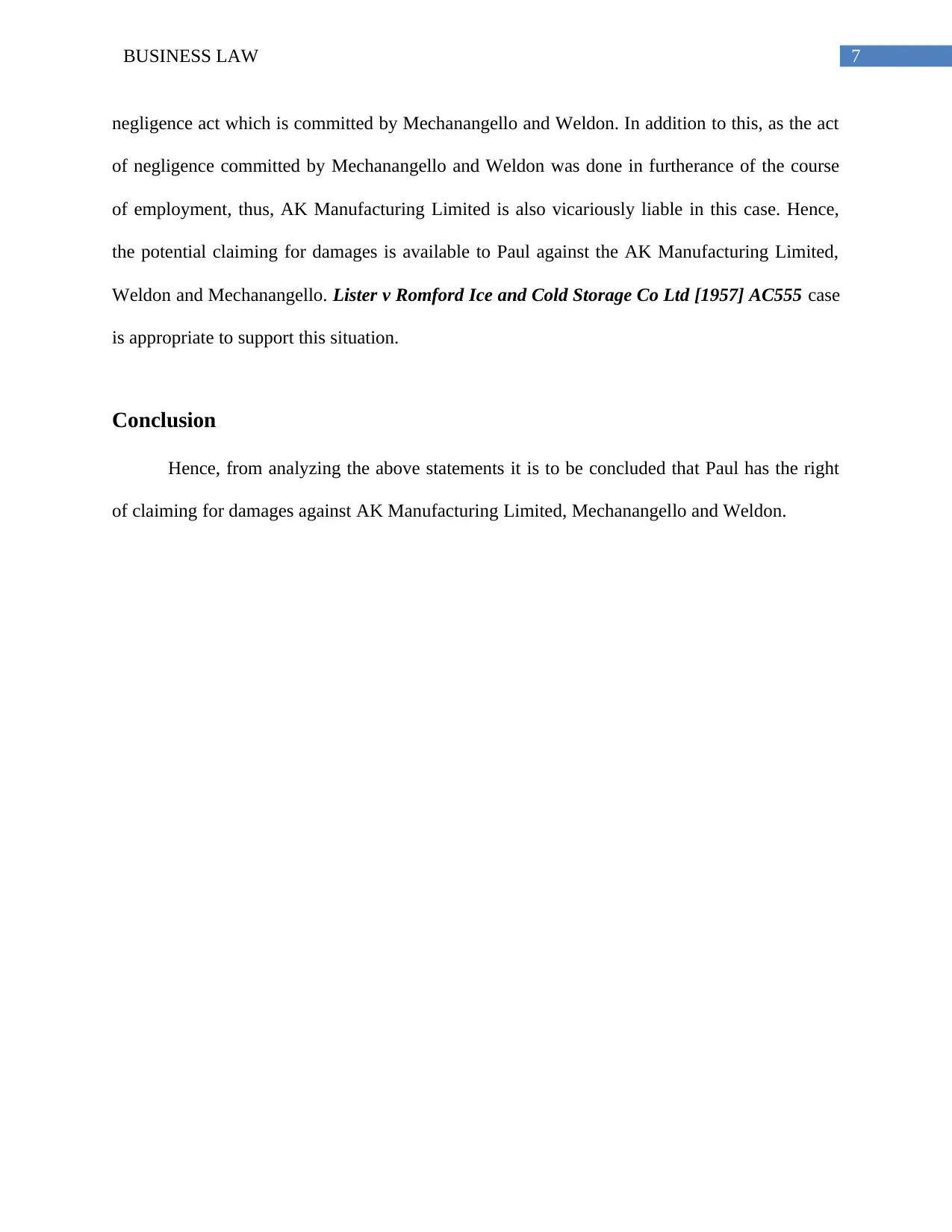
7BUSINESS LAW
negligence act which is committed by Mechanangello and Weldon. In addition to this, as the act
of negligence committed by Mechanangello and Weldon was done in furtherance of the course
of employment, thus, AK Manufacturing Limited is also vicariously liable in this case. Hence,
the potential claiming for damages is available to Paul against the AK Manufacturing Limited,
Weldon and Mechanangello. Lister v Romford Ice and Cold Storage Co Ltd [1957] AC555 case
is appropriate to support this situation.
Conclusion
Hence, from analyzing the above statements it is to be concluded that Paul has the right
of claiming for damages against AK Manufacturing Limited, Mechanangello and Weldon.
negligence act which is committed by Mechanangello and Weldon. In addition to this, as the act
of negligence committed by Mechanangello and Weldon was done in furtherance of the course
of employment, thus, AK Manufacturing Limited is also vicariously liable in this case. Hence,
the potential claiming for damages is available to Paul against the AK Manufacturing Limited,
Weldon and Mechanangello. Lister v Romford Ice and Cold Storage Co Ltd [1957] AC555 case
is appropriate to support this situation.
Conclusion
Hence, from analyzing the above statements it is to be concluded that Paul has the right
of claiming for damages against AK Manufacturing Limited, Mechanangello and Weldon.
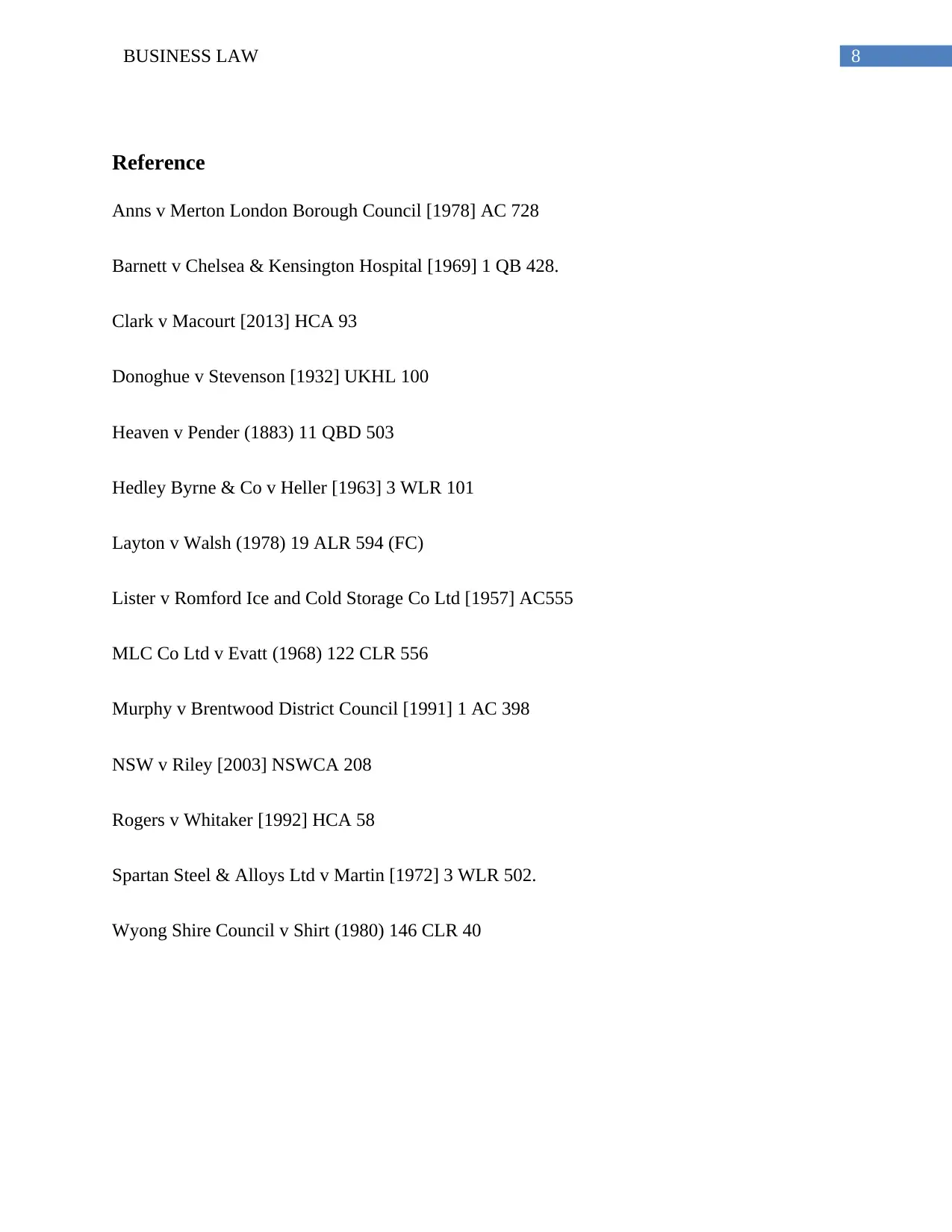
8BUSINESS LAW
Reference
Anns v Merton London Borough Council [1978] AC 728
Barnett v Chelsea & Kensington Hospital [1969] 1 QB 428.
Clark v Macourt [2013] HCA 93
Donoghue v Stevenson [1932] UKHL 100
Heaven v Pender (1883) 11 QBD 503
Hedley Byrne & Co v Heller [1963] 3 WLR 101
Layton v Walsh (1978) 19 ALR 594 (FC)
Lister v Romford Ice and Cold Storage Co Ltd [1957] AC555
MLC Co Ltd v Evatt (1968) 122 CLR 556
Murphy v Brentwood District Council [1991] 1 AC 398
NSW v Riley [2003] NSWCA 208
Rogers v Whitaker [1992] HCA 58
Spartan Steel & Alloys Ltd v Martin [1972] 3 WLR 502.
Wyong Shire Council v Shirt (1980) 146 CLR 40
Reference
Anns v Merton London Borough Council [1978] AC 728
Barnett v Chelsea & Kensington Hospital [1969] 1 QB 428.
Clark v Macourt [2013] HCA 93
Donoghue v Stevenson [1932] UKHL 100
Heaven v Pender (1883) 11 QBD 503
Hedley Byrne & Co v Heller [1963] 3 WLR 101
Layton v Walsh (1978) 19 ALR 594 (FC)
Lister v Romford Ice and Cold Storage Co Ltd [1957] AC555
MLC Co Ltd v Evatt (1968) 122 CLR 556
Murphy v Brentwood District Council [1991] 1 AC 398
NSW v Riley [2003] NSWCA 208
Rogers v Whitaker [1992] HCA 58
Spartan Steel & Alloys Ltd v Martin [1972] 3 WLR 502.
Wyong Shire Council v Shirt (1980) 146 CLR 40
⊘ This is a preview!⊘
Do you want full access?
Subscribe today to unlock all pages.

Trusted by 1+ million students worldwide
1 out of 9
Related Documents
Your All-in-One AI-Powered Toolkit for Academic Success.
+13062052269
info@desklib.com
Available 24*7 on WhatsApp / Email
![[object Object]](/_next/static/media/star-bottom.7253800d.svg)
Unlock your academic potential
Copyright © 2020–2025 A2Z Services. All Rights Reserved. Developed and managed by ZUCOL.




